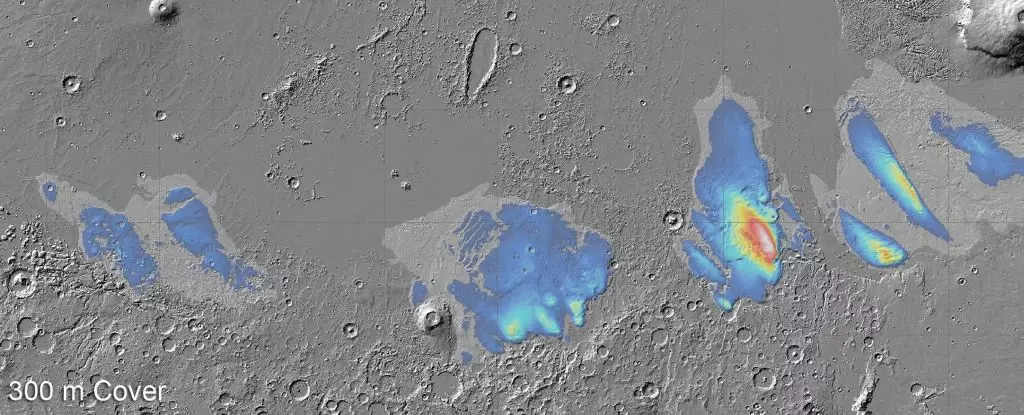Mars, often seen as a barren and lifeless planet, has recently revealed its hidden secrets through new technological advancements. A recent radar survey of the Medusae Fossae Formation region on Mars has uncovered what seems to be massive slabs of buried water ice, several kilometers thick. This discovery challenges our previous understanding of Mars and suggests that the planet is not as devoid of water as once believed.
The Medusae Fossae Formation is a collection of massive deposits that stretch along the equator of Mars, spanning a distance of about 5,000 kilometers. These deposits separate the lowlands in the northern hemisphere from the cratered highlands in the south. Originally detected in 2007, the deposits were observed up to a depth of 2.5 kilometers, but their nature was unknown at the time. However, new radar data from Mars Express’s MARSIS radar has revealed that these deposits are even thicker than previously thought, measuring up to 3.7 kilometers in depth.
Layered Ice: Mars’s Hidden Reservoir
The radar signals observed in the Medusae Fossae Formation match those observed from Mars’s polar caps, which are known to be rich in ice. This suggests that the buried deposits are also composed of layered ice. In fact, scientists estimate that there is as much water buried in the formation as there is in Earth’s Red Sea. If this water were brought to the surface and melted, it would cover Mars in a shallow ocean ranging from 1.5 to 2.7 meters in depth.
The Mystery of the Medusae Fossae Formation
The origins of the Medusae Fossae Formation are still unknown, but its unique characteristics have fascinated scientists. These deposits, sculpted by the strong winds that traverse Mars, stand several kilometers high. The region remains poorly understood, prompting scientists to further investigate its properties and formation.
Decoding the Data: Ice vs Other Materials
To determine the composition of the buried deposits, researchers performed extensive analyses and modeling. Various possibilities were considered, such as buried dust, volcanic material, sediment from previous wetter periods, and water ice. Surprisingly, only water ice provided a good fit for the observed data. The density of the deposits and their behavior could not be replicated by any ice-free materials. This solidifies the hypothesis that the Medusae Fossae Formation is rich in water ice.
Implications for Mars’s History and Future Exploration
The discovery of significant amounts of buried water ice holds crucial implications for our understanding of Mars and its potential for future human exploration. Mars, once thought to be devoid of water, now presents evidence of a dynamic climatic history. Previous observations have already indicated the presence of water in the form of rivers, lakes, and oceans in Mars’s past. The newfound buried water ice adds to this growing body of evidence and raises questions about where the water has gone, whether it evaporated into space or remains hidden within the planet.
Water as a Resource for Future Exploration
As humans set their sights on Mars, the availability of water becomes a critical factor for potential colonization and survival. If water resources are already present on the planet, it would greatly reduce the amount of water that future missions would need to bring from Earth. However, the buried water ice in the Medusae Fossae Formation remains inaccessible beneath several hundred meters of Martian dust.
The recent analysis of the Medusae Fossae Formation challenges our existing knowledge of Mars and opens up new avenues for exploration. By understanding the history and transformation of Mars, scientists can gain insights into the planet’s climate and its evolution into its current state. The discovery of massive buried water ice formations leads to questions about when these ice deposits formed and what Mars was like during that time.
The new radar survey of the Medusae Fossae Formation has revolutionized our understanding of Mars and its water resources. The detection of extensive buried water ice highlights the dynamic nature of the planet and provides hope for the presence of water in other regions. As we continue to unlock the secrets of Mars, we strive to uncover its enigmatic history and pave the way for future exploration and potential human colonization.

Leave a Reply